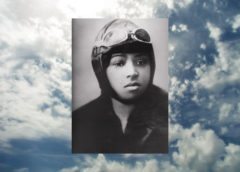Bessie Coleman was born on January 26, 1892, in Atlanta, Texas, the tenth of thirteen children to sharecroppers. When Coleman was two years old, her family moved to Waxahachie, Texas, where she lived until age 23.
Starting at the age of six, Coleman had to walk four miles each day to attend her segregated, one-room school in Waxahachie, where she loved to read. She also established herself as an outstanding math student. She completed all eight grades in that school. Every year, Coleman’s routine of school, chores, and church was interrupted by the cotton harvest. At the age of 12, Bessie was accepted into the Missionary Baptist Church School on scholarship.
When she turned eighteen, she took her savings and enrolled in what is now called Langston University, in Langston, Oklahoma, where she attended for one semester. In 1916 at the age of 23, she moved to Chicago, Illinois, where she lived with her brothers.
In Chicago, she worked as a manicurist at the White Sox Barber Shop where she heard stories from pilots returning home from World War I about flying during the war. This gave her the drive to follow her dream of flying, so she took a second job in a chili parlor to help pay for it.
One of the main opticals she faced was that American flight schools admitted neither women nor blacks. Robert S. Abbott, founder and publisher of the Chicago Defender, her about her pursuits and encouraged her to study abroad. Coleman took a French-language class at the Berlitz school in Chicago and then traveled to Paris on November 20, 1920 so she could earn her pilot license.
She learned to fly in a Nieuport 82 biplane with “a steering system that consisted of a vertical stick the thickness of a baseball bat in front of the pilot and a rudder bar under the pilot’s feet. On June 15, 1921, Coleman became the first woman of African-American and Native American descent to earn an aviation pilot’s license and to earn an international aviation license from the Fédération Aéronautique Internationale.
Determined to polish her skills, Coleman spent the next two months taking lessons from a French ace pilot near Paris and in September 1921 she sailed for New York. She became a media sensation when she returned to the United States.
With the age of commercial flight still a decade or more in the future, Coleman quickly realized that in order to make a living as a civilian aviator she would have to become a “barnstorming” stunt flier, and perform for paying audiences. But to succeed in this highly competitive arena, she would need advanced lessons and a more extensive repertoire. Returning to Chicago, Coleman could not find anyone willing to teach her, so in February 1922, she sailed again for Europe. She spent the next two months in France completing an advanced course in aviation, then left for the Netherlands to meet with Anthony Fokker, one of the world’s most distinguished aircraft designers. She also traveled to Germany, where she visited the Fokker Corporation and received additional training from one of the company’s chief pilots. She then returned to the United States to launch her career in exhibition flying.
On April 30, 1926, in Jacksonville, Florida. Coleman had recently flew her plane from Dallas in preparation for an airshow. She had to make three forced landings along the way because the plane had been so poorly maintained. Coleman’s friends and family did not consider the aircraft safe and implored her not to fly it.
On take-off, with her mechanic and publicity agent, William D. Wills flew the plane with Coleman in the other seat. She had not put on her seatbelt because she was planning a parachute jump for the next day and wanted examine the terrain. About ten minutes into the flight the plane unexpectedly went into a dive and then a spin.
Coleman was thrown from the plane at 2,000 ft (610 m) and died instantly when she hit the ground.
William Wills was unable to regain control of the plane and it plummeted to the ground. Wills died upon impact and the plane exploded and burst into flames. Although the wreckage of the plane was badly burned, it was later discovered that a wrench used to service the engine had jammed the controls.
Coleman died at 34 years old.
Coleman would not live long enough to establish a school for young black aviators but her pioneering achievements served as an inspiration for a generation of African-American men and women. “Because of Bessie Coleman,” wrote Lieutenant William J. Powell in Black Wings (1934), dedicated to Coleman, “we have overcome that which was worse than racial barriers. We have overcome the barriers within ourselves and dared to dream.” Powell served in a segregated unit during World War I, and tirelessly promoted the cause of black aviation through his book, his journals, and the Bessie Coleman Aero Club, which he founded in 1929.
More info, visit: Bessie_Coleman

Rod is a blogger, writer, filmmaker, photographer, daydreamer who likes to cook. Rod produces and directs the web series, CUPIC: Diary of an Investigator. He is also the editor, producer and administrator of STM Daily News, a part of the TNC Network.


